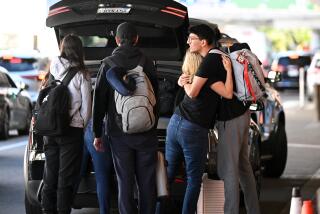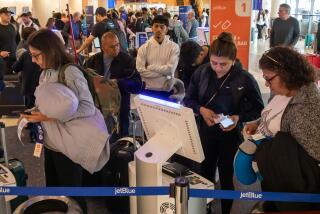Air traffic fell in ‘08; prospects for ’09 dim
U.S. airline traffic fell in 2008 for only the fifth time since the government began tracking the data 35 years ago as the global economy weakened and carriers slashed schedules.
Traffic, measured in miles flown by paying passengers, slid 2.3% for the seven biggest U.S. carriers, led by a 6.5% drop for United Airlines. Any positive results pending from smaller airlines won’t be enough to make up the shortfall and prevent 2008 from snapping a streak of five annual gains.
Air travel probably will slump again this year because Delta Air Lines Inc. and other carriers plan to chop seating capacity by as much as 8% on top of their 2008 pullbacks. Traffic has fallen in back-to-back years only once, in 2001-02, based on U.S. Transportation Department records dating to 1974.
The airlines are trying to figure out just how tough 2009 will be, said Hunter Keay, an analyst at Stifel Nicolaus & Co. in Baltimore.
Keay estimates U.S. carriers will cut flights about 10% more in 2009, with traffic slipping 5% to 10%.
Record jet fuel prices in mid-2008 prompted the biggest airlines to ground more than 460 planes, slash 26,000 jobs and reduce capacity by 10% or more as they rushed to lower costs and shrink operations.
The drop for 2008 was confirmed Wednesday when Delta, the world’s biggest carrier; newly acquired Northwest Airlines; and US Airways Group Inc. became the last of the big carriers to report December and full-year results.
UAL Corp.’s United led December traffic declines, with a 12% plunge, its 16th straight monthly decline. The carrier cut available seats almost 13% for the month.
AMR Corp.’s American Airlines, the No. 2 U.S. carrier, said traffic fell 8.2%, a 10th consecutive drop. Continental Airlines Inc. posted a 7.3% slide, its fourth in a row.
Combined traffic for the seven biggest carriers fell 5.2% for December.
Delta and Southwest Airlines Co. were the only members of that group to post gains last month, up 3% and 1.1% respectively. Full-year traffic also rose for both.
Air traffic in the United States hadn’t fallen since 2002, in the wake of the Sept. 11, 2001, terrorist attacks. While an industrywide decline would crimp tax receipts and hurt businesses such as hotels, the biggest airlines should post combined profits of about $5 billion in 2009, estimated Michael Derchin, an analyst at FTN Midwest Securities in New York.
More to Read
Inside the business of entertainment
The Wide Shot brings you news, analysis and insights on everything from streaming wars to production — and what it all means for the future.
You may occasionally receive promotional content from the Los Angeles Times.










